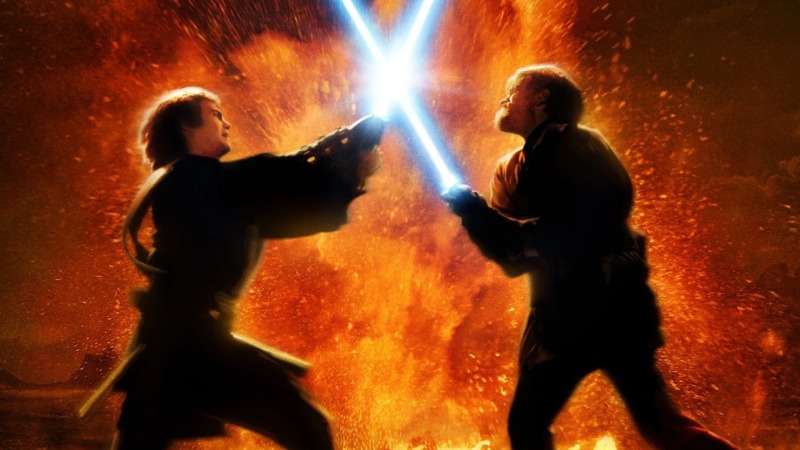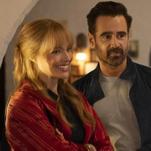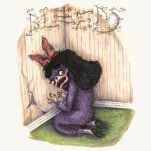Revenge of the Sith At 20: George Lucas’ Magnum Opus Is Remembered For The Wrong Reasons

There aren’t many instances in film history of collective opinion changing like the passionate insistence by Generation Z that “the Star Wars prequels were good, actually.” Despite surpassing box office records in their initial theatrical windows, George Lucas’ three Star Wars prequels were greeted with such unanimous criticism that the phrase “The Phantom Menace effect” was coined to describe disappointment with a hotly-anticipated new release. Even before the Star Wars sequel trilogy inadvertently started a cultural war with the Internet’s most loathsome trolls, speculation about the impending release of The Force Awakens was generally capped off with the reflection that “at least it won’t have midi-chlorians and Senate meetings.”
There were early signs that not all of the criticisms leveled at Lucas were well-founded; the controversial reliance on computer generated imagery did lay the groundwork for films like Pirates of the Caribbean and Rise of the Planet of the Apes, John Williams did craft many iconic, incredible new tracks, and there was nothing to complain about with regards to Ewan McGregor’s performance as Obi-Wan Kenobi. Although the backlash was reflective of how deeply the original three films had resonated with audiences, there was also a fair amount of bad faith bullying of prequel actors, most notably Ahmed Best and Jake Lloyd.
Perhaps, it was the success of Star Wars: The Clone Wars, the animated series that expanded on some of the most confusing aspects of Lucas’ worldbuilding, that began the resurgence in the prequels’ popularity; maybe, the transparent cynicism of micromanaged studio blockbusters like Transformers and Man of Steel showed that Lucas’ greatest sin was ambition, and that if nothing else, his prequels felt like the voice of a singular artist. Strangely enough, the irony-pilled rise of internet memes about “The Tragedy of Darth Plagueis The Wise” and “The Droid Attack on The Wookiees” generated goodwill for some of the prequels’ stranger ideas. Nonetheless, the turnaround became so extreme that the 20th anniversary re-release of Star Wars: Episode III- Revenge of the Sith has been greeted with fanfare from a generation that has grown to consider it as a generational classic, rather than any kind of disappointment.
Revenge of the Sith is a popular choice among Star Wars fans as the best prequel, as it did away with many of the more childish antics of its two predecessors; the romantic scenes between Anakin and Padme may be just as cringe-inducing, but Revenge of the Sith also boasts five lightsaber duels and the first PG-13 rating of the franchise. However, Revenge of the Sith’s cultural stickiness suggests that audiences were at least unconsciously aware of the radical politics at the heart of Lucas’ dramatic space opera. Despite being lambasted as an excuse to sell action figures, Revenge of the Sith is in fact a dire warning about turning over executive power to a fear-mongering dictator, who scapegoated peacekeepers and painted himself as the victim.
The most laughable complaint leveled at the new era of Star Wars (and Rian Johnson’s work on The Last Jedi in particular) is that the franchise has become “too political.” It’s hard to imagine that these dissenters had any comprehension of what Lucas’ original trilogy was even about; with villains called “Storm Troopers” and ragged rebel groups reminiscent of the Viet Cong, Lucas wasn’t being particularly subtle with his allusions to world history. In fact, the original Star Wars (now known as A New Hope) is best viewed as the third entry in the trilogy of anti-authoritarian films that Lucas directed in the 1970s. THX-1138, American Graffiti and Star Wars all centered on a young protagonist who is radicalized by a group of diverse outcasts that reject the status quo, and finds his purpose through rebellion and self-actualization.
Although the political backdrop was evident in the original film, most notably with the dissolution of the Imperial Senate by Grand Moff Tarkin, Lucas made this subtext the primary driving factor of the overarching Star Wars narrative in The Phantom Menace. Corporate greed makes way for violence when the Trade Federation’s blockade of Naboo becomes an invasion, leaving the ignorant Galactic Senate impotent to defend their subjects. This created a situation in which Ian McDiarmid’s Senator Palpatine can rise to power on the promise of offering “protection,” in what is evidently a dog-whistle for militarization. By the end of Attack of the Clones, Palpatine has orchestrated a galactic conflict in which he controls both sides; through chaos and confusion, he is able to expand and extend the powers of his office in a manner that could be described as “Cheney-esque.”
Attack of the Clones was too far along in post-production to be truly affected by the 9/11 attacks, even if the haphazard Battle of Geonosis evoked imagery of Operation Desert Storm. However, Revenge of the Sith was developed amidst the apex of the Bush administration, in which nationalistic talking points had become mainstream. “You’re either with us, or you’re with the terrorists,” the President famously remarked in the aftermath of the September 11 tragedy. Anakin would subsequently shout “you’re either with me, or you’re my enemy” to his shell-shocked Jedi mentor during the fiery battle on Mustafar.
The three year gap between Attack of the Clones and Revenge of the Sith (both in real life and in the Star Wars canon) allowed Lucas to ensure that the galaxy far, far away had escalated at the same pace as the real world. By 2005, America had already begun its hunt for “weapons of mass destruction,” as those “in-the-know” had willfully ignored the obvious financial ramifications of an invasion of the Middle East. The same dispirited acknowledgment of the cyclical nature of war is present within the beginning of Revenge of the Sith, when it becomes apparent that Palpatine will move the goalposts in order to hold on to his advanced authority. The death of Count Dooku does not move the needle one inch, as Palpatine admits to Mace Windu that “the Senate will vote to continue the war” as long as General Grievous is still alive.
Lucas’ direction is often accused of being stagnant, as there’s nothing that is particularly appealing about a group of characters standing in front of a generic CGI background. However, the visual banality in Revenge of the Sith feels like a calculated choice; although there are intercut moments on war-torn planets like Kashyyyk, Anakin and Padme are still able to enjoy a romantic evening on the deck of their apartment against the backdrop of an infinite metroplex. War may not bring real consequences to the privileged, but it has steadily shaped the parameters of their society. Palpatine’s offices and brigades are etched in royal red colors, with guards standing alongside him decked in the imposing outfits of Roman Imperials. In the most radical instances, his impassioned speeches to the Senate Chambers call upon imagery from Triumph of the Will.
Lucas’ biggest gamble with the prequel trilogy had nothing to do with visual effects, as he tasked himself with turning the most fearsome villain in cinematic history into a bright, wide-eyed kid, who eventually becomes a lovesick teenager loner. Although the romantic yearnings of Anakin’s “I hate sand” speech in Attack of the Clones were certainly cringe-inducing, Lucas understood that the orchestrators of fascism often begin as disaffected, angry young men who feel that they are not understood. What makes Anakin’s arc so tragic is that many of his arguments are well-founded; the Senate is indeed overrun with corruption, the Jedi have been ignorant to galactic slavery, and a charismatic charlatan like Dooku has used wealth and influence to gain political capital.
Like so many young men who are influenced by right-wing extremism, Anakin is quick to accept the most radical solutions to what infuriates him, as Palpatine’s plainspoken honesty can be mistaken for integrity. If the Senate could be disbarred, the Jedi Temple could be burned to the group, and the leaders of the Confederacy could be executed, would the galaxy really be a better place? In Anakin’s eyes, the inaction of his mentors has made it more attractive to accept the easiest solution, even if it means sacrificing the oaths that he has taken. His dramatic attack on Mace Windu is the result of rage built up after years of subjugation and adherence to an antiquated set of rules that have not proven effective in sustaining peace.
Shakespeare was an undeniable inspiration for Lucas, as a more generous reading of the stilted romantic dialogue in Attack of the Clones is that the melodramatic musings between Anakin and Padme were an homage to the heightened emotions of Romeo and Juliet. The work of The Bard is even more prominent in Revenge of the Sith, as Lucas even inserted a literal “space opera” in the background of a critical conversation between Anakin and Palpatine. In the vein of Othello or Macbeth, Anakin’s downfall is the result of misunderstandings, coincidences, and manipulation; the tragic irony is that he is doomed to wear an iron suit as a result of events that were entirely avoidable.
Lucas’ interest in the seductive nature of evil were apparent since the original trilogy, even if there was little threat that Luke would actually join the Dark Side after seeing what it was capable of. Yet, Revenge of the Sith hints that radicalization is unceremonious when democratic infrastructure has collapsed. Anakin’s inability to see the totalitarianism that Palpatine is hinting at is understandable, given that he has watched the “protectors of the peace” become wartime generals. Obi-Wan’s notion that the Republic will return to normal after the war concludes point to his idealism; Lucas doesn’t challenge the notion that people are fundamentally good, but he does suggest that they’re less likely to be defiant if fascism does not impact them directly.
Revenge of the Sith picked up traction from critics of its two predecessors because of the overt differences in pacing; if viewers had to wait more than an hour during Attack of the Clones between the Coruscant chase to Obi-Wan’s battle with Jango Fett on Kamino, then Revenge of the Sith bombards them with an extended opening sequence involving various forms of combat. Although Lucas certainly enjoys seeing the visual achievements that his effects department were capable of, there’s a meaninglessness to every set piece in Revenge of the Sith that creates an aura of uneasiness. The lighthearted quips in Anakin’s duel with Dooku take a disturbing turn when he’s given the opportunity to inflict the same harm on the Sith apprentice that he faced three years prior, when his hand was removed. Similarly, Obi-Wan’s extended battle with General Grievous, although entertaining, is ultimately a distraction so that he could not intervene in Anakin’s rendezvous with Palpatine.
The more affecting moments of violence in Revenge of the Sith are far less sensational; the ease with which Palpatine cuts through Windu’s team of Jedi Masters is a direct inversion of the formality of the Jedi lightsaber training seen in the other films. Similarly, Lucas homages his lifelong best friend Francis Ford Coppola’s work on The Godfather with his Order 66 sequence, in which the confused Jedi Masters are gunned down by their clone soldiers in various planets across the galaxy. There’s nothing heroic in their martyrdom; these Jedi die confused, defenseless, and alone. Even an instance of Anakin brutally executing the Separatist leaders confined to Mustafar does not offer any catharsis; it’s simply another example of pawns being knocked down so that new pieces can take their place.
The much-hyped, climactic duel between Anakin and Obi-Wan shares this senseless quality. Although there may be many flips, twirls, and other force-assisted gymnastics involved, the results of the duel were evident from the moment an infuriated Anakin lashed out at Padme, in what remains the most disturbing depiction of domestic abuse in the entire franchise. Anakin’s actions aren’t the calculated strategy of a mustache-twirling villain, but the blind rage of a sick young man determined to express his anger in the most violent means possible. Like the many adherents to the current totalitarian regime that dominates America, there is no backbone to Anakin’s platform; within a matter of minutes, he suggests overthrowing the Sith Lord he just swore allegiance to, and pledges himself to the woman he subsequently chokes to death.
Even if the events of the original trilogy hadn’t given shape to where the narrative of Revenge of the Sith needed to end, the “brother against brother” feud concludes with the inevitable. Anakin has failed too many times to accept rehabilitation with agency, yet poses too much of an active threat to be forcefully contained. Lucas is often insistent on tying up nearly every loose end, in case anyone was confused why C-3PO didn’t remember anything in A New Hope. However, the tragic act of Obi-Wan’s self-exile does give Revenge of the Sith a component of ambiguity; was his inability to kill Anakin an indication of his empathy, or confirmation of his cowardice?
The simplicity with which Lucas depicted galactic politics, which may have felt too blunt in 2005, now feels almost laughably idealistic in the age of Trump. Despite having the face of a literal Universal Monster, Palpatine at least asks for the Senate’s permission to crown himself Emperor, and shows concern about discrediting the public perception of his scapegoats before ruthlessly annihilating them. To his credit, “the Republic will be reorganized into the first Galactic Empire, for a safe and secure society,” is a far more elegant way of saying “make the galaxy great again.”
A blockbuster film like Revenge of the Sith may not be possible again, both within or outside the Star Wars franchise, as Lucas constructed a story in which the only catharsis is knowing the iconic events that will follow; the rare viewers who hadn’t watched the original trilogy may have been left to conclude that Lucas was an unabashed cynic who believed societal collapse was inevitable. Even other “origin” stories about quintessential cinematic villains have struggled on how to contend with an inherently evil protagonist; if a film like Joker seemed confused on how much sympathy should be granted to the titular character, then Wicked fully sanded off the edges of the original source material.
Revenge of the Sith is by no means a perfect film, and it’s unfortunate that it’s often defended by those that see it as the alternative to Disney-era progressiveness. The Last Jedi and Revenge of the Sith share the same skepticism about mythology, even if Johnson seems more interested in how the past can be rebuilt into something new. The faults within Revenge of the Sith are many, as Lucas’ treatment of female characters leaves much to be desired, and the open acknowledgment of Qui-Gon’s ghostly spirit raises far too many questions about the nature of the Jedi afterlife. Nonetheless, the line “this is how liberty dies, with thunderous applause,” may be the most radical quote from any film that also had a toy line, a Burger King tie-in promotion, and a LEGO video game. It’s only fitting that it came from the ultimate Hollywood outsider, who arose from the radicalization of the New Hollywood era to create an independent creative empire unburdened by studio interference.
Liam Gaughan is a film critic, writer, and entertainment journalist with over twelve years experience writing about popular culture. His bylines include Polygon, Dallas Morning News, Dallas Observer, High on Films, Central Track, Collider, Taste of Cinema, Slashfilm, and Movieweb. He also posts ramblings and thoughts on Letterboxd and X at @TheLiamGaughan.







































